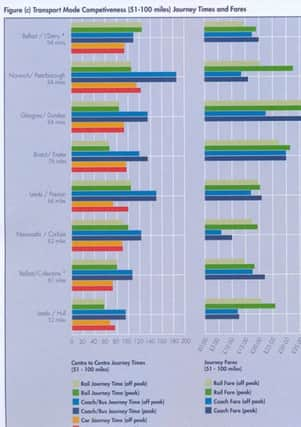Auditor callsfor quickertrain timeson city line


Investment in public transport here is also much lower compared with other parts of the United Kingdom.
Mr Kieran Donnelly, the Comptroller and Auditor General, said: “Public transport has enjoyed substantial investment of £1.1billion in the first decade of this century.
Advertisement
Hide AdAdvertisement
Hide Ad“However, passenger numbers have not increased have not increased significantly and the car remains the dominant mode of transport. The Department of Regional Development (DRD) needs to do more to attract people onto public transport and make it their choice mode of travel.”


Amongst his finding are that the Londonderry to Belfast rail line is one of the worst for journey times.
It compared journey times, fares and service frequency on routes across Ireland and Britain.
“The results illustrate that Northern Ireland Railways (NIR) is competitive with road journeys on selected routes for shorter commuting journeys but less competitive for longer journeys.
Advertisement
Hide AdAdvertisement
Hide Ad“This is particularly true for Belfast - Londonderry and Belfast - Dublin where, in the case of the former, not only is the car more attractive, but also the coach in terms of frequency.


“In the case of the Belfast - Londonderry journey, the routing of rail via Coleraine helps to explain the lack of competitiveness in time and frequency terms,” the new report states.
Elsewhere, the report points out how under-funded buses and trains are in Northern Ireland compared with the rest of the UK.
Figures from HM Treasury show that despite a recent increase expenditure on public transport per head has been “much lower compared with other parts of the UK” and that “until the recent dip in roads expenditure in 2011/12, the profile of expenditure on roads has increased significantly.
Advertisement
Hide AdAdvertisement
Hide AdThe auditors said: “The Department has told us that the balance of funding between roads and public transport here largely reflects the maintenance needs of the local road network and the fact that the rail network is less extensive than that of its UK counterparts, together wit the need for significant investment in the strategic road network to build regional connectivity and address the legacy of under-investment over previous decades.
“The Department also takes the view that expenditure per kilometre of road length is a more appropriate measure of comparison because of the importance of maintenance expenditure.
“However, in our view the analysis presented is appropriate and applies standard measures based on published HM Treasury data.
“The use of a supply side measure of road network is unlikely to encourage the intended re-balance towards public transport.”